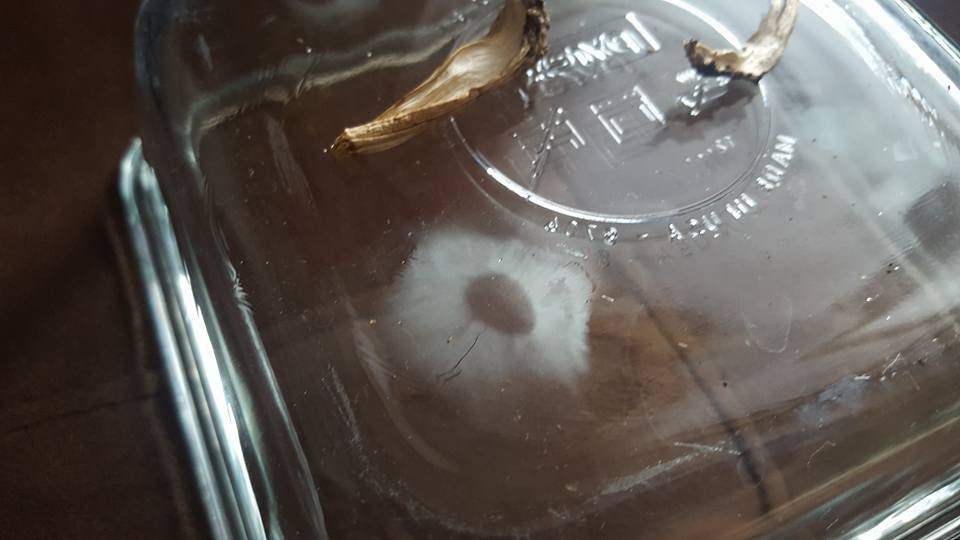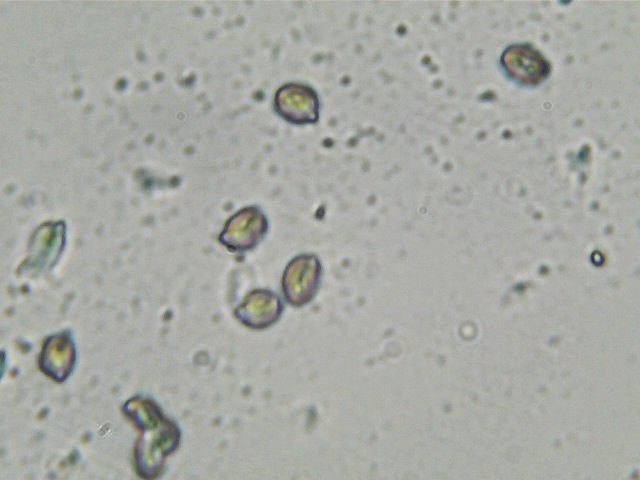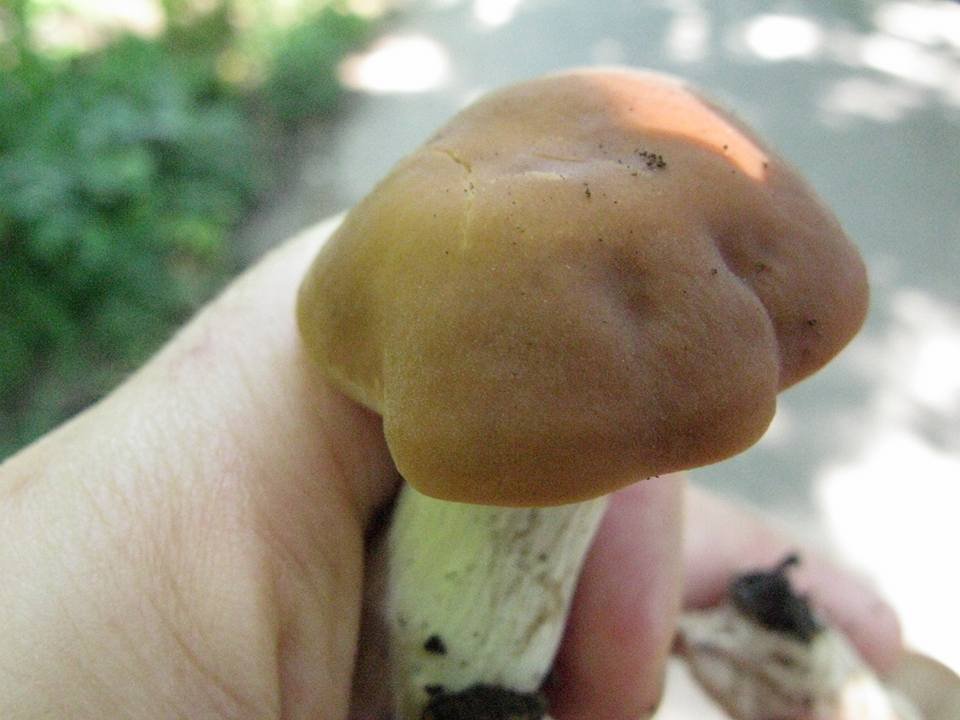These posts are not for foraging. They are intended for entertainment and intellectual satisfaction only. These posts are not a field guide nor comprehensive in any way - their accuracy is not assured in any way. Do not eat wild mushrooms unless you are a professional, have substantial professional assistance or have a wealth of personal experience with a specific species. Do not make any foraging decisions based on these posts. To do so could be dangerous or life threatening.
These Posts Contains No Information Regarding Edibility Or Toxicity
This is a momentous occasion in the Amateur Mycologist's brief history!
First, we've made it to the 20th species! That the 20th species should be "Lyophyllum decastes" is sort of funny, because L.decastes isn't really representative of any single mushroom. In fact, by all accounts, L. decastes seems to incorporate a series of mushrooms, all of whom don't seem to fit well anywhere else. In order to arrive at L.decastes in this particular case I underwent quite an investigation, along with some help from local mycological sources.
Although it was not super helpful in furthering the ID in this case, this also brings me to another exciting announcement: For the first time the Amateur Mycologist has tried his hand at microscopy!
Now, before you get too excited, let me rein in your expectations. I don't have a very good microscope, and I am not very good at using it. But everyone's got to start somewhere. I'll save the big reveal for the end.
In the meantime, let's get to know our specimen.
The mushrooms you see at the top are younger caps taken from the larger cluster pictured directly above.
As you can see, the mature caps of this particular species have become fairly broad. The mushrooms were growing in a tight cluster on organic debris nearing the consistency of wood-chips in the northern forested portion of Central Park.
The park was absolutely overrun with the desiccated remains of another, more famous clustering mushroom known as Armillaria tabescens, or the Honey Mushroom, pictured to the right. At first glance, you could be forgiven for thinking that all of the pictures in this post so far are all the same mushroom. Indeed, when I first stumbled upon what I am calling L.decastes, I thought it was just a wider capped example of A.tabescens. But closer examination belies that assumption.
First, go back to the top two pictures and take a close look at the caps of the L.decastes specimens. The older mushrooms are cracked, and have some detritus on them, but they don't bear any real texture. Meanwhile the younger mushrooms at the top of the post display a near perfect smoothness.
Now compare that to a close up of one of the A.tabescens clusters I found
These heavily textured, almost scabrous caps are completely different in texture than the L.decastes mushrooms.
Take a look also at the stems of the A.tabescens mushrooms. Long and skinny, twisting in order to reach the top of the tightly packed cluster.
One of the defining traits of A.tabescens is that it is effectively the only Armillaria species which has no anullus - meaning no remnants of a veil hanging on its stem from the mushroom's youth.
Now, compare the lanky, slightly darkened stem of that A.tabescens to the beautifully plump stem of L.decastes
Look at the size of those stems! Could they be less like A.tabescens?
Once you compare these mushrooms side by side, it quickly becomes clear they are not the same species. But then if these smooth capped, clustering mushrooms growing on debris or wood-chips with broad, white, plump stems are not A.tabescens, the question remained, what were they?
My mind jumped to the possibility of a Lactarius species. We've covered Lactarius Indigo before. Remember that the Lactarius genus is famous for exuding a milk or latex when the mushroom cap or gills are damaged. Luckily, this is an easy enough characteristic to test, at least in broad strokes. So I took one of the caps and simply tore a chunk off to see what happened.
But no milk! No latex! The Mystery Deepens!
And keep in mind, although these mushrooms were certainly mature, they were in no way desiccated. In fact, they were immensely plump, firm to the touch and had the most delightful sweet mushroomy odor with just a hint of fruitiness.

So, they are not Armillaria and they are not Lactarius. I took home one of the young mushrooms, cut up the cap and watched the flesh to see if it changed color. It did not and remained white. Then I placed the pieces gill side down onto a glass Tupperware and left them there to collect a spore print. I also left the stem pieced to see how they fared over time. The mushroom deposited a white spore print.
Armed with this piece of information, I tried to go to mycokey online and plug in everything I knew. The result was a laundry list of Lactarius and Russula species. But looking through them proved fruitless as nothing quite fit the bill.

At this point I asked for some help from local mycology enthusiasts in NYC. The first suggestion was that perhaps these mushrooms fell into the Gymnopus genus. In response I gave specific consideration to Gymnopus luxurians. It was the closest option which both grew in clusters and had a similarly textured cap. However, the stems were quite thinner - and the caps darker overall. As a result, I was dubious.
Finally, it was Gary Lincolf who commented that it might be this other genus I had never even heard of before called Lyophyllum. Looking up the genus led me to Kuo's page on Lyophyllum decastes, or what used to be known as Clitocybe multiceps. Kuo indicates that L.decastes is not really a single species, but rather a range of species who share a number of similar characteristics and don't really fit anywhere else. Specifically:
- They tend to grow in clusters, on disturbed ground - (e.g. a path in central park)
- Their spore print is white
- They have no anullus or veil
- There cap can be white, brown, brownish or gray brown
- White or whitish gills that sometimes yellow with age.
- And spores which are, "more or less" round.
That's a lot of traits, and a good amount of wiggle room. But the pictures tend not to lie, and if you compare the photos I provide here with the L.decastes images available online the resemblance is striking. Add on the presence of all of the above traits, and you have a member of the strange conglomeration of mushrooms known as L.descastes.
I did want to try and confirm the "more or less" round part of the spore identification. Luckily, this, at least, was something I could "more or less" accomplish.
I proudly present the first microscopic photo in the Amateur Mycologist series!

Is it a masterstroke of microscopic excellence?
OK, not exactly. It's pretty blurry, and not nearly detailed enough to get much more than the general outline of a few spores. But luckily, in this case, all we need to know is that they are "more or less" round, and we can soundly say, "indeed they are!"
This rudimentary observation was mercifully simple to make. Once the spores are deposited on the glass after the spore print is completed, just take a fresh razor blade, scrape off a good amount of the spores and then deposit some on a fresh glass slide. I happened to have distilled water lying around and so I picked up a tiny drop on the razor and let it fall on the spores, then placed a cover slip on top.
The results leave much to be desired. The eye pieces for this cheap microscope don't have any kind of ruler and so I can't measure the size of the spores. Plus, the magnification with the lens capable of digital recording maxes out at a (blurry) 800x. At that magnification - with such low quality resolution - it is very difficult to make out more than general shape.
Additionally, I have not even begun using the various reagents necessary to either enhance the microscopic visuals of the spores, or draw conclusions about their chemical makeup.
But, we had to start somewhere! The fact that this first effort garnered something with even a modicum of relevant and material data is good enough for me.

Macroscopic Characteristics
Cap/Flesh: 3-12cm - young ones are convex. They get very broad in maturity, even cracking as they flatten out a bit. The color varies pretty heavily within L.decastes - Kuo says white, yellow, brown, brown-grey. Smooth textured. Flesh was white and did not change color after being damaged.
Gills: The gills of the mushrooms I have here are just barely attached to the stem. Apparently this varies also within the L.decastes group - sometimes attached clearly, sometimes even a little decurrent. Always fairly close packed. Mine did not appear to have yellowed with age.
Stems: The great give away here - thick, Kuo says up to 2cm, but these were more than that in parts. 5-10 cm long is also estimated. Definitely smooth, as you can see in the photos. Definitely white or whitish. Definitely dry.
Ecology: Saprobic, which is why I found it growing on a bunch of dead wood-chips on the path through the northern forested part of Central Park. Appears to be a summer and fall mushroom - and grows in clusters, as seen here.
Distribution: Throughout North America with these found in NYC
Other Traits: These had a delicious odor - mushroomy, sweet and slightly fruity.
Microscopic Traits: Relevant for our purposes - spores are either round or nearly round.
THIS POST IS NOT INTENDED FOR FORAGING PURPOSES AND TO USE IT FOR THOSE PURPOSES WOULD BE DANGEROUS. DO NOT HUNT WILD MUSHROOMS WITHOUT RELYING ON A COMBINATION OF PROFESSIONAL FIELD GUIDES, IN PERSON PROFESSIONAL GUIDANCE, OR IN PERSON GUIDANCE BY SOMEONE TRUSTWORTHY WHO HAS COPIOUS LOCAL, SPECIALIZED MUSHROOM HUNTING EXPERIENCE. FAILURE TO DO SO CAN RESULT IN GRIEVOUS PERSONAL HARM OR DEATH.
Support @steemstem and the #steemstem project - curating and supporting quality STEM related content on Steemit
Information Sources:
New York Mycological Society
http://www.mushroomexpert.com/lyophyllum_decastes.html
https://en.wikipedia.org/wiki/Lyophyllum_decastes
http://www.mushroomexpert.com/armillaria_tabescens.html
http://www.first-nature.com/fungi/armillaria-tabescens.php
http://www.mushroomexpert.com/gymnopus_luxurians.html
http://www.mushroomexpert.com/lactarius.html
http://www.mycokey.com/
Photo Sources:
All photos are my own OC - except:
[Photo #9 of Gymnopus luxurians]This image was created by user Sava Krstic (sava) at Mushroom Observer, a source for mycological images. CC BY-SA 3.0 via Wikimedia Commons
